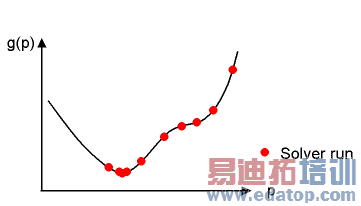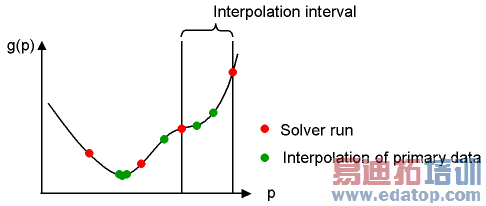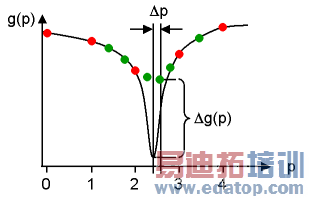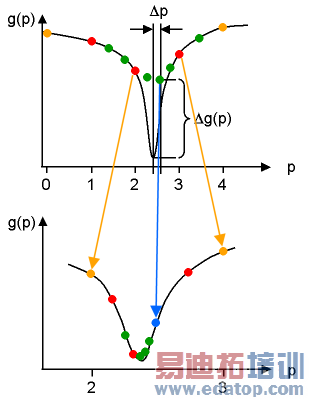- 易迪拓培训,专注于微波、射频、天线设计工程师的培养
CST2013: Optimizer - Interpolation of Primary Data
The optimizer supports the interpolation of primary data. The interpolation strategy allows you to significantly reduce the number of actual solver runs. The following two charts demonstrate this behavior by comparing optimizer runs with and without the support of interpolation of primary data. The goalfunction g(p) is plotted versus the parameter value p in both charts.
Comparison of optimization with and without support of interpolation of primary data
| (a) Optimization without support of interpolation of primary data: For each parameter value, p, the optimizer sets one solver run as necessary to acquire the goal function value g(p). This is indicated by the red dots.
|
| (b) Optimization with support of interpolation of primary data: Solver runs are only necessary for certain parameter values p (red dots). These parameter values—also called samples—define the interpolation intervals. If the optimizer tries to acquire a goal function value g(p) at a parameter p between the interpolation interval (green dots,) the goal function value will be calculated by interpolation of primary data instead of running the solver. |
Defining the sample locations
Of course, the result of the optimization depends on the location and the number of the samples. If you use the optimizer with support of interpolation of primary data, you may set the number of samples. Please see the Optimizer Settings page of the optimizer dialog box on how to select the optimizer with support of primary data.
The location of the samples depend on the number of samples, the initial parameter value that is used upon optimizer start, and the minimum and maximum values a parameter can take. These values can be entered on the Optimizer Settings page of the optimizer dialog box.
The initial parameter value is always taken as one sample . Therefore, the interpolation intervals to the left and right hand sides of this initial parameter value may be of different size. However, the optimizer tries to locate the samples such that the difference between the interpolation interval sizes on the left and right hand sides of the initial parameter value are as small as possible. Therefore, the initial parameter value may not be located at the middle sample. The following chart shows the different interpolation intervals.
|
Location of the samples depending on the number of samples, the initial value and the minimum and maximum value. The initial parameter value is displayed with a blue dot. The minimum and maximum parameter values are displayed in orange. The red dots show the remaining samples. The number of samples is set to 7 in this example. |
Increasing interpolation accuracy
Of course, running the solver at each sample may result in a goal function value that is more accurate than interpolating the primary data and calculating the goal function value out of the interpolated data. If the course of the goal function g(p) shows peaks, the interpolation results may differ from the solver results. The next chart demonstrates this.
|
The interpolation of primary data (green dots) may lead to a minimum shifted by Dp and a difference in the goal function Dg. |
This behavior may occur if a small number of samples is taken for a wide parameter range. To increase the interpolation accuracy, you may increase the number of optimizer passes. This causes the optimizer to restart after having found the initial optimum with an internally down-scaled parameter range. The initial parameter value of the additional optimizer run is set to the optimum of the previous optimizer run. The next chart demonstrates this behaviour.
|
The second optimizer pass (lower chart) is started with new minimum and maximum values and the same number of samples. The initial parameter value is taken from the optimal parameter of the first optimizer pass. The interpolation results become more accurate in the second pass. |
CST微波工作室培训课程套装,专家讲解,视频教学,帮助您快速学习掌握CST设计应用
上一篇:CST2013: Choosing a problem type
下一篇:CST2013: Curve Creation
 最全面、最专业的CST微波工作室视频培训课程,可以帮助您从零开始,全面系统学习CST的设计应用【More..】
最全面、最专业的CST微波工作室视频培训课程,可以帮助您从零开始,全面系统学习CST的设计应用【More..】
频道总排行
- CST2013: Mesh Problem Handling
- CST2013: Field Source Overview
- CST2013: Discrete Port Overview
- CST2013: Sources and Boundary C
- CST2013: Multipin Port Overview
- CST2013: Farfield Overview
- CST2013: Waveguide Port
- CST2013: Frequency Domain Solver
- CST2013: Import ODB++ Files
- CST2013: Settings for Floquet B





